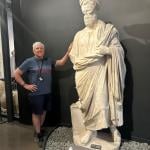I endorsed Rabbi Evan Moffic’s book as a good example of civil discourse and dialogue. I hope that we can engage in public discussions about Jesus.
Today Rabbi Evan Moffic releases a new book about the Jewishness of Jesus. Rabbi Moffic is a well-known congregational rabbi outside of Chicago whose first book answered the question What Every Christian Needs to Know About Passover. This second book, What Every Christian Needs to Know about Jewishness of Jesus: A New Look at History’s Most Influential Rabbi grapples with the bigger and more controversial questions: What do Christians need to know about Judaism, and what do Jews need to know about the Jewish Jesus? This book will challenge and enrich you. Here’s an intriguing excerpt from it.
Did Jesus Have a Bar Mitzvah?
The second chapter of the Gospel of Luke depicts the 12-year-old Jesus teaching at the Temple in Jerusalem. The family had traveled there for the Passover holiday. Passover was one of the three pilgrimage holidays during which Jewish families would travel to Jerusalem to observe the festival at the Temple. Since the text tells us Jesus was age twelve, this visit may also have marked the time of his becoming a Bar Mitzvah.
A Bar Mitzvah is a Jewish coming-of-age ceremony for young men that typically happens at age thirteen. The young man says a blessing over the Torah, reads from it and also chants a selection from one of the Prophetic books. He then teaches about those passages. Although Jesus was not yet thirteen, it would not be unthinkable for a 12-year-old to have a Bar Mitzvah ceremony. It happens in my own synagogue occasionally.
A Part of Jesus’ Jewish Education
This ceremony was likely a part of the Jewish education Jesus received. That education starts at age three with study of Scripture and continues with study of the Mishnah—the first book of Jewish law—at age ten. The Bar Mitzvah at age 13 marks a commitment to following Jewish law.
We do not know the extent of Jesus’s Jewish education, but given how deeply Jewish teaching informs Jesus’s adult teachings, it would probably have been extensive. Remember, Joseph and Mary find him in the Temple “sitting among the teachers.” While we do not know what texts and questions they were discussing, these kinds of debates were a critical part of study.
Mary’s presence is especially noteworthy, as mothers did not have the Jewish legal responsibility for a child’s education, and she would not have been able to accompany Jesus into certain parts of the Temple. These parts of the Temple were inaccessible to women, though a special women’s section also existed where men were not permitted.
Can We Call Jesus a Rabbi?
The second purpose of this story is to establish Jesus as a rabbi. A rabbi needed a thorough Jewish education, and this text from the Luke is the only picture we have from Jesus’s adolescent and young adult life.
Some writers and theologians have argued that we should not call Jesus a rabbi because the title did not officially exist during his lifetime. It is only after the destruction of the Jerusalem Temple in 70 CE that the great teachers of the time are called “Rabbi.”
But calling Jesus rabbi is fine as long as we recognize that the title describes a cultural status rather than an official position. That is the way in which the Gospels use the title. They refer to Jesus as a “rabbi” or “my rabbi” several times. These references do not come exclusively from his disciples. They come from a lawyer, a large crowd, and a priest.
Why is this important to Christians today? Because it reminds us of the how important study and textual analysis is the religious life. Jesus lived and grew up in a culture thick with textual study and piety.
In contrast to the surrounding Roman culture, whose ideal type was a warrior, he lived within a Jewish matrix whose ideal type was the scholar. That is why we meet the young-adult Jesus, for the first and only time, as he is studying and debating with sages in the Temple.
To get the free study guide that accompanies this book on the Jewishness of Jesus, click here.











